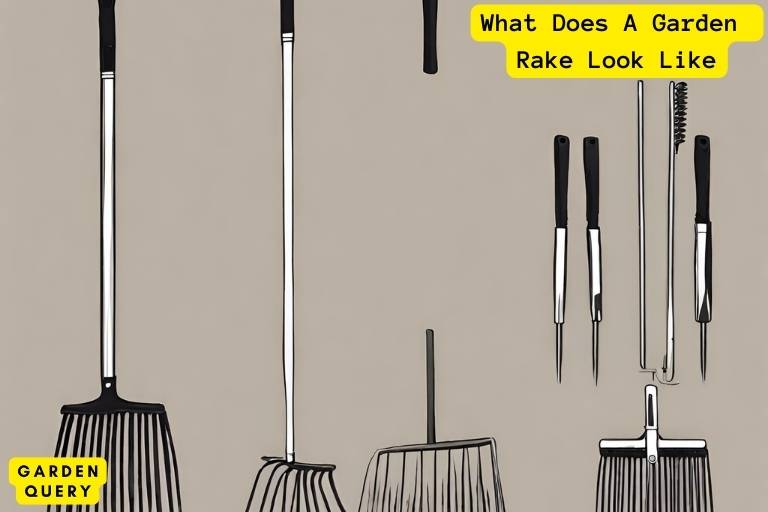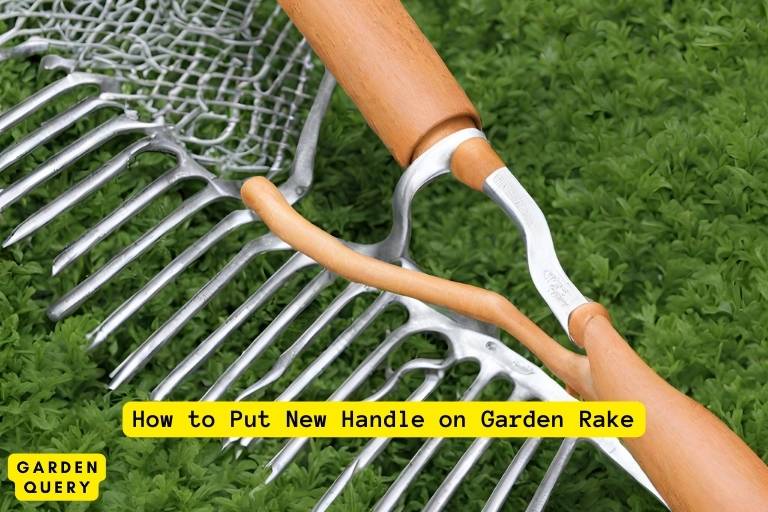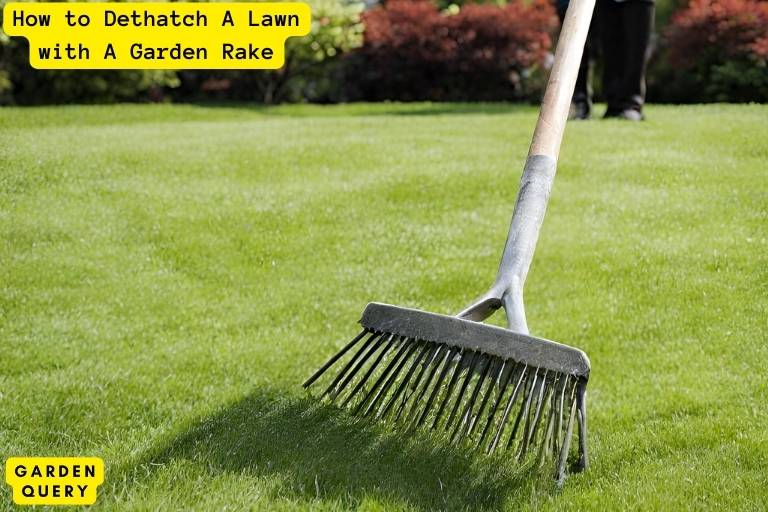How to Rake A Garden? Simple Guide!
Raking a garden is an essential task that helps maintain its cleanliness and promotes healthy plant growth. It involves removing fallen leaves, twigs, and other debris from the garden’s surface, ensuring proper air circulation and sunlight penetration. Raking is not only beneficial for the appearance of your garden, but it also prevents the growth of weeds and reduces the risk of plant diseases. In this article, we will discuss the benefits of raking a garden and the tools and equipment needed to get the job done effectively.

Benefits of Raking a Garden
Raking your garden comes with several benefits:
1. Improved Appearance: By removing debris and fallen leaves, raking gives your garden a clean and manicured look. It helps showcase the beauty of your plants and flowers.
2. Disease Prevention: Leaves and debris can accumulate moisture, creating an ideal environment for fungal diseases to thrive. Raking regularly prevents disease-causing organisms from spreading and harming your plants.
3. Weed Control: Raking helps remove weed seeds from the soil’s surface, reducing the chances of weed growth. This saves you time and effort in manual weeding.
4. Air Circulation: A buildup of leaves and debris can restrict airflow to your plants’ roots and prevent proper ventilation. Raking promotes air circulation, ensuring the health and vitality of your garden.
Tools and Equipment Needed
To rake your garden efficiently, you will need the following tools and equipment:
1. Leaf Rake: A leaf rake is a specialized tool with wide, fan-shaped tines designed to gather leaves, grass clippings, and other lightweight debris. It is essential for effectively collecting and removing unwanted materials from your garden.
2. Garden Gloves: Protect your hands from potential hazards, such as thorny branches or sharp objects, by wearing sturdy garden gloves. They provide an extra layer of safety and prevent blisters or cuts.
3. Leaf Bags or Cart: Once you’ve raked everything, you’ll need a way to gather and transport the debris. Consider using leaf bags or a garden cart to make the cleaning process more convenient.
4. Wheelbarrow or Compost Bin: If you have a compost pile, a wheelbarrow or compost bin can help transport organic materials for composting. This way, you can turn the garden waste into nutrient-rich compost instead of disposing of it.
Taking the time to rake your garden regularly not only keeps it looking tidy but also provides numerous benefits for plant health and growth. So, grab your rake and start transforming your garden into a clean and vibrant space!
Remember, if you need more information on raking or any other gardening tips, feel free to check out Wikipedia’s gardening article for comprehensive details. Happy raking!
Clearing Debris
When it comes to maintaining your garden, raking is an essential task. Raking not only helps to keep your garden tidy but also promotes healthy growth by removing debris that can hinder plant growth. Here are a few steps to guide you on how to rake a garden effectively.
Removing Leaves and Twigs
1. Start by using a leaf rake: A leaf rake is a wide-headed rake with flexible tines, specifically designed for collecting leaves and other lightweight debris. Begin by raking the leaves into piles, starting from one corner of your garden and working your way across. Be sure to gather all the leaves from flower beds, lawns, and pathways.
2. Gather the debris: Once you have collected the leaves into piles, use the rake to scoop them up and place them into a garden bag or compost bin. Make sure to remove any twigs or branches that may have fallen along with the leaves.
Clearing Weeds and Grass
1. Use a garden hoe: A garden hoe is a versatile tool that can be used for various tasks, including clearing weeds and grass. Gently run the hoe across the soil to loosen the weeds and grass. Then, use the rake to gather and remove them from the garden.
2. Dispose of the debris: Similar to the leaves, collect the weeds and grass using the rake and transfer them to a garden waste bag or compost bin. It’s important to remove these unwanted plants to prevent them from competing with your desired plants for nutrients and sunlight.
By regularly raking your garden, you can effectively clear debris, such as leaves, twigs, weeds, and grass, keeping your garden clean and healthy. Additionally, raking can improve soil aeration and drainage, promoting better plant growth.
Remember to take breaks and pace yourself when raking to avoid strain or fatigue. It’s also a good idea to wear protective gloves and long sleeves to avoid any injuries from sharp debris. Happy raking!
Leveling the Soil
If you’re looking to create a smooth and even surface in your garden, leveling the soil is an essential step. It allows for proper water drainage, prevents pooling, and makes gardening tasks such as planting and mowing easier. Here’s how to get started:
Using a Garden Rake for Leveling
- Begin by removing any large rocks, sticks, or debris from the area you want to level. This will help ensure a clean and even surface.
- Take a sturdy garden rake with flat, even tines. A bow rake or a landscape rake are both suitable options for this task.
- Hold the rake with a firm grip and use the tines to rake the soil in a back-and-forth motion. Start from one end of the area and work your way towards the other, overlapping each stroke slightly to ensure even coverage.
- As you rake, pay attention to the high and low spots in the soil. Use the back edge of the rake to break up clumps or move excess soil from high areas to fill in the lower areas.
- Continue raking and leveling the soil until you achieve a smooth, even surface. Take breaks periodically to step back and assess the progress.
Balancing Uneven Areas
If you have areas with significant slopes or unevenness, additional steps may be necessary to achieve a level garden:
- One option is to create terraces or raised beds to accommodate the uneven areas. This involves building walls or using materials such as timber or stones to create level platforms for planting.
- Alternatively, you can use a garden leveling tool, such as a lawn leveling rake or a leveling board, to help distribute soil evenly and fill in low areas. These tools can be used in conjunction with a garden rake to achieve a smoother surface.
Remember to regularly water and compact the soil as you level to ensure stability and prevent future settling. It’s also important to periodically evaluate and maintain the levelness of your garden as the soil may shift over time due to natural factors such as erosion or settling.
Leveling your garden not only enhances its appearance but also provides better conditions for plant growth and maintenance. So grab your garden rake, roll up your sleeves, and get ready to create a beautiful and even garden space!
For more information on gardening and soil preparation, check out the gardening article on Wikipedia.
Preparing for Planting
When it comes to preparing your garden for planting, raking plays a crucial role in achieving optimal soil conditions. Raking the soil helps to loosen it and create a seedbed or planting area that is ideal for seeds or transplants to thrive. Here’s a step-by-step guide on how to properly rake your garden:
Raking the Soil to Loosen It
- Start by removing any large rocks, sticks, or debris from the area you plan to rake. These obstacles can hinder the process and disrupt the evenness of the soil.
- Use a garden rake with sturdy tines to loosen the top layer of soil. Begin by raking in one direction, such as from north to south, then rake again from east to west. This crisscross motion helps to break up clumps and ensure an even distribution of soil particles.
- Pay attention to particularly compacted areas or hard soil patches. Apply more pressure with the rake in these areas to break up the soil further.
- Continue raking until the soil is crumbly and loose. Avoid over-raking, as this can result in excessive soil disturbance and nutrient loss.
Creating Seedbeds or Planting Areas
- After raking the soil to loosen it, you can create seedbeds or planting areas for your seeds or transplants.
- Use the back of the rake or a garden hoe to level the soil and smooth out any remaining unevenness. This step helps to create a flat surface for planting and ensures good seed-to-soil contact.
- If you prefer to have raised planting beds, use the rake to gather the loosened soil into mounds or rows.
- For evenly spaced seeds or transplants, you can also use the rake to create furrows or indentations in the soil. This makes it easier to place seeds or transplants at the right depth and spacing.
Remember to follow the specific planting instructions for the seeds or transplants you are using, including the recommended planting depth and spacing. Proper soil preparation and raking will provide a smooth and fertile surface for your plants to grow and thrive.
By using the right techniques for raking, you can ensure that your garden is well-prepared for planting and that your plants have the best chance of success. Happy gardening!
Maintenance and Care
Taking care of your garden is important to ensure healthy growth and a beautiful landscape. One essential task in garden maintenance is raking. Raking not only helps remove debris and fallen leaves but also serves several other purposes that promote the overall health of your garden. In this section, we will explore two significant benefits of raking: preventing soil compaction and promoting aeration and water absorption.
Raking to Prevent Soil Compaction
One of the primary reasons for raking your garden is to prevent soil compaction. Over time, the ground can become compacted due to heavy foot traffic, rainfall, or natural settling. Compacted soil restricts the flow of air, water, and nutrients to the plant roots, hindering their growth. By raking regularly, you loosen the top layer of soil, helping to break up any compaction and improving the overall soil structure. This allows roots to penetrate more deeply and access vital resources, leading to healthier plants.
Raking for Aeration and Water Absorption
Another advantage of raking is that it promotes aeration and water absorption. When you remove leaves, grass clippings, and other debris from your garden, you create space for air to circulate. Adequate air circulation is crucial for the root system as it ensures the exchange of gases, including oxygen and carbon dioxide, which are necessary for respiration. Additionally, raking helps prevent the buildup of excessive moisture in your garden by clearing any obstacles that might prevent water from being absorbed by the soil. Effective water absorption is crucial for plant growth and helps prevent issues such as root rot.
In summary, raking is an essential task in garden maintenance that offers multiple benefits. By raking regularly, you can prevent soil compaction, enhance aeration, and improve water absorption in your garden. These actions contribute to the overall health and vitality of your plants, resulting in a vibrant and flourishing landscape.
Leaf Management
Taking care of your garden and keeping it clean is an essential part of maintaining its health and aesthetic appeal. One important task in garden maintenance is leaf management. During the fall season, leaves can quickly accumulate and clutter your garden. To effectively manage leaves, using a garden rake is a practical solution.
Using a Garden Rake for Leaf Collection
1. Choosing the right rake: There are different types of rakes available, but for leaf collection, a wide-toothed garden rake is most suitable. This type of rake allows you to gather leaves effectively without damaging the grass or plants underneath.
2. Starting at one end: Begin your leaf collection by starting at one end of the garden and working your way across. Use your rake to gather the leaves into piles. Push the rake down into the ground and pull it back towards you, allowing the leaves to accumulate.
3. Raking technique: Use a raking technique that suits your comfort and efficiency. You can either rake in a straight line or use a back-and-forth motion. Keep in mind that using short strokes is more effective than long strokes, as it prevents leaves from scattering.
4. Dispose of leaves: Once you have gathered the leaves into piles, you can dispose of them in an environmentally friendly manner. One option is to make leaf mulch, which can be used as a natural fertilizer for your garden. Another option is to bag the leaves and leave them for the municipal waste collection, ensuring they are properly disposed of.
Proper Disposal of Leaves
Proper disposal of leaves is crucial to maintain a clean environment and prevent blockages in drainage systems. Here are a few options for disposing of leaves:
1. Leaf mulch: As mentioned earlier, turning leaves into mulch is a sustainable way to recycle them. Mulching leaves helps improve soil quality, retain moisture, and suppress weed growth.
2. Composting: Leaves can also be added to your compost pile. Adding a layer of leaves to your compost helps balance the carbon-to-nitrogen ratio and speeds up the decomposition process.
3. Municipal waste collection: Check with your local authorities about the proper disposal methods for leaves. Many municipalities provide specific collection dates or designated collection sites for garden waste, including leaves.
Proper leaf management not only keeps your garden clean but also promotes the overall health of your plants. By using a garden rake and following proper disposal methods, you can effectively manage leaves and maintain a beautiful garden. Remember, a little effort in leaf management goes a long way in maintaining a tidy and vibrant outdoor space.
Seasonal Raking
Raking is an essential task for maintaining a healthy and tidy garden. Depending on the season, there are different reasons and techniques for raking. Let’s explore how to rake a garden effectively and the benefits of seasonal raking.
Spring Raking for Rejuvenation
In the spring, raking serves as an important rejuvenation process for your garden. It helps remove debris, dead leaves, and any other winter buildup. By raking the soil surface gently, you can break up any matted grass or thatch, allowing new grass blades to emerge easily. This process also helps aerate the soil and allows it to receive sunlight and moisture effectively. Additionally, raking in the spring stimulates new growth and prevents pests or diseases from harboring in any decaying matter. It is recommended to rake the garden in early spring when the soil is dry enough to avoid damaging the grass roots.
Fall Raking for Leaf Removal
During the fall season, one of the primary reasons for raking is leaf removal. As the trees shed their leaves, they can accumulate and smother the grass beneath, depriving it of vital sunlight. By regularly raking fallen leaves, you can prevent the grass from suffocating, promote air circulation, and reduce the likelihood of diseases such as snow mold. Fallen leaves can also be collected and used as mulch or added to compost, providing valuable nutrients for your garden in the future. Raking during fall also allows you to identify any potential lawn issues like bare patches or areas in need of reseeding, so you can take appropriate action before winter arrives.
It’s important to note that while raking is a beneficial garden maintenance task, it should be done carefully to avoid damaging the grass or plants underneath. Use a rake with flexible tines and avoid putting too much pressure on the soil.
By properly timing and executing seasonal raking, you can help maintain a healthy and vibrant garden throughout the year. Remember to dress appropriately, wear gardening gloves and use the right tools for the job. Happy raking!
Safety Precautions
When it comes to raking your garden, safety should be a top priority. Here are some important safety precautions to keep in mind to ensure a safe and injury-free gardening experience.
Protective Clothing and Gear
1. Wear Gloves: Before you start raking, make sure to wear a pair of sturdy gardening gloves. Gloves will protect your hands from thorns, splinters, and blisters that can occur while handling branches and debris.
2. Eye Protection: It’s also a good idea to wear protective eyewear such as safety glasses or goggles. This will shield your eyes from any flying debris like dirt, stones, or twigs that may be kicked up during the raking process.
3. Long Pants and Sleeves: Wearing long pants and sleeves will provide protection against scratches and insect bites. It will also help prevent contact with poisonous plants such as poison ivy or oak.
Avoiding Strain and Injury
1. Warm Up: Gardening can be physically demanding, so it’s essential to warm up your muscles before you start raking. Stretching and doing some light exercises will help prevent muscle strain and injuries.
2. Use Proper Body Mechanics: When raking, maintain a comfortable stance with your feet shoulder-width apart. Position yourself close to the rake, bend your knees, and engage your core muscles. This will help prevent back strain and distribute the workload evenly.
3. Take Frequent Breaks: Raking can be tiring, especially for longer gardening sessions. Take regular breaks to rest and hydrate. This will help prevent exhaustion and reduce the risk of accidents from fatigue.
Remember, safety should always come first when raking your garden. By following these safety precautions, you can enjoy your gardening tasks without any worries. Happy raking!
- Best Therapists In Dallas - February 1, 2024
- Holly Willoughby Husband: Holly Willoughby’s Love Story - January 30, 2024
- Holly Willoughby Dress: 5 Style Secrets and 7 Must-Know Career Milestones - January 30, 2024





